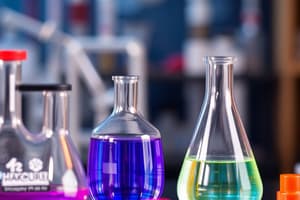Podcast
Questions and Answers
What is the main purpose of qualitative analysis of organic compounds?
What is the main purpose of qualitative analysis of organic compounds?
- To separate mixtures of compounds
- To identify the functional groups present in an organic compound (correct)
- To determine the boiling point of a compound
- To synthesize new compounds
Which physical method is used to determine the polarity of a compound?
Which physical method is used to determine the polarity of a compound?
- Melting point
- Solubility (correct)
- Chromatography
- Boiling point
What is the purpose of TLC in qualitative analysis?
What is the purpose of TLC in qualitative analysis?
- To separate and quantify components of a mixture
- To synthesize new compounds
- To determine the molecular weight of a compound
- To identify compounds based on their Rf values (correct)
Which chemical method is used to identify the presence of specific functional groups?
Which chemical method is used to identify the presence of specific functional groups?
What is the purpose of acetylation in derivatization?
What is the purpose of acetylation in derivatization?
Which spectroscopic method is used to determine the structure of a compound based on its molecular skeleton?
Which spectroscopic method is used to determine the structure of a compound based on its molecular skeleton?
What is the purpose of mass spectrometry in qualitative analysis?
What is the purpose of mass spectrometry in qualitative analysis?
What is the approach that combines physical, chemical, and spectroscopic methods to identify an unknown compound?
What is the approach that combines physical, chemical, and spectroscopic methods to identify an unknown compound?
Flashcards are hidden until you start studying
Study Notes
Qualitative Analysis of Organic Compounds
Importance
- Identifies the functional groups present in an organic compound
- Determines the structure of an unknown compound
- Helps in the synthesis of new compounds
Methods
Physical Methods
- Melting Point: helps identify compounds with similar structures
- Boiling Point: provides information about the molecular weight and intermolecular forces
- Solubility: indicates the polarity of the compound
- Chromatography: separates, identifies, and quantifies components of a mixture
- TLC (Thin Layer Chromatography): identifies compounds based on their Rf values
- GC (Gas Chromatography): separates and identifies volatile compounds
- HPLC (High-Performance Liquid Chromatography): separates and identifies non-volatile compounds
Chemical Methods
- Classification Tests: identify the presence of specific functional groups
- Alkane Tests: bromine water, KMnO4, and acidified KMnO4
- Alkene Tests: bromine water, KMnO4, and acidic KMnO4
- Alkyne Tests: ammoniacal silver nitrate and acidic potassium permanganate
- Aromatic Tests: bromine water and iron(III) chloride
- Derivatization: converts a compound into a derivative with distinct properties
- Acetylation: forms an acetate ester
- Benzoylation: forms a benzoyl ester
Spectroscopic Methods
- IR (Infrared) Spectroscopy: identifies functional groups based on their absorption frequencies
- NMR (Nuclear Magnetic Resonance) Spectroscopy: determines the structure of a compound based on its molecular skeleton
- 1H NMR: provides information about the hydrogen atoms in a molecule
- 13C NMR: provides information about the carbon atoms in a molecule
- Mass Spectrometry: determines the molecular weight and structure of a compound based on its fragmentation pattern
Combination of Methods
- Systematic Approach: combines physical, chemical, and spectroscopic methods to identify an unknown compound
- Deductive Reasoning: uses the results of various tests to narrow down the possibilities and identify the compound
Importance of Qualitative Analysis
- Qualitative analysis identifies functional groups in organic compounds
- It determines the structure of unknown compounds
- It aids in the synthesis of new compounds
Physical Methods of Qualitative Analysis
- Melting point helps identify compounds with similar structures
- Boiling point provides information about molecular weight and intermolecular forces
- Solubility indicates the polarity of the compound
- Chromatography separates, identifies, and quantifies components of a mixture
Chromatography Techniques
- TLC (Thin Layer Chromatography) identifies compounds based on their Rf values
- GC (Gas Chromatography) separates and identifies volatile compounds
- HPLC (High-Performance Liquid Chromatography) separates and identifies non-volatile compounds
Chemical Methods of Qualitative Analysis
- Classification tests identify specific functional groups
- Alkane tests use bromine water, KMnO4, and acidified KMnO4
- Alkene tests use bromine water, KMnO4, and acidic KMnO4
- Alkyne tests use ammoniacal silver nitrate and acidic potassium permanganate
- Aromatic tests use bromine water and iron(III) chloride
- Derivatization converts compounds into derivatives with distinct properties
- Acetylation forms an acetate ester
- Benzoylation forms a benzoyl ester
Spectroscopic Methods of Qualitative Analysis
- IR (Infrared) Spectroscopy identifies functional groups based on absorption frequencies
- NMR (Nuclear Magnetic Resonance) Spectroscopy determines the structure of a compound based on its molecular skeleton
- 1H NMR provides information about hydrogen atoms in a molecule
- 13C NMR provides information about carbon atoms in a molecule
- Mass Spectrometry determines molecular weight and structure based on fragmentation pattern
Combination of Methods for Identification
- Systematic approach combines physical, chemical, and spectroscopic methods to identify an unknown compound
- Deductive reasoning uses results of various tests to narrow down possibilities and identify the compound
Studying That Suits You
Use AI to generate personalized quizzes and flashcards to suit your learning preferences.




